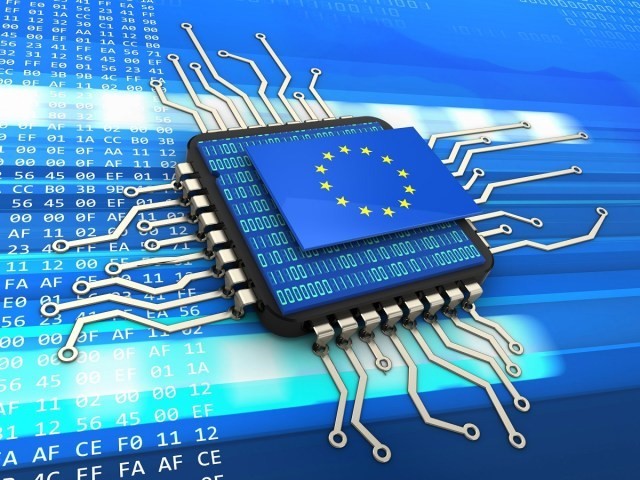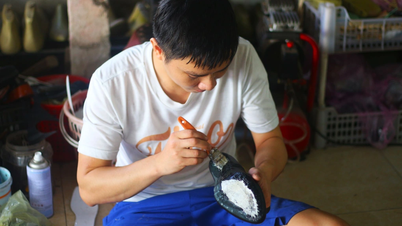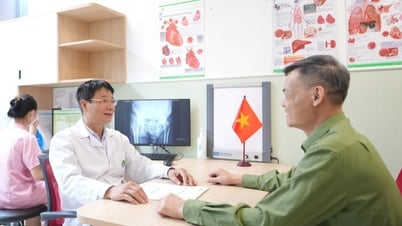 |
| EU actively launches chip 'campaign', new dawn or technology desert? (Source: https: eetimes.eu) |
Semiconductor chips are the “brains” of electronic devices, used in everything from children's toys, home appliances, smartphones, to electric cars and sophisticated weapons.
Where is Europe?
Almost all of the raw materials needed to make chips are now produced in China. Taiwan, home to many of the world’s leading chipmakers, accounts for more than half of global chip production, while many of the world’s biggest chip designers, such as Nvidia, and device makers like Apple, are from the United States.
The Semiconductor Industry Association, a U.S. trade group, said U.S. companies accounted for 48 percent of the global chip industry last year. South Korea, home to the giant Samsung, was second with 14 percent. And Europe was third with a 9 percent share.
The semiconductor supply chain is suffering unprecedented shortages, due to the lasting impact of disruptions during the Covid-19 pandemic. The crisis has spurred governments to act, with the US and China soon entering a fierce competition for dominance and introducing increasingly tough measures to secure their supply chains.
As for Europe, after the chaos in the global chip supply chain after the pandemic, they have realized the dependence of European electronics manufacturers on the ecosystem of Asian semiconductor manufacturers, furthermore, the increasing risk of geopolitical risks... Europe has started to act with billion-dollar plans.
With the aim of strengthening the semiconductor ecosystem and self-reliance in Europe’s supply chains this decade, all 22 EU member states adopted a joint statement on semiconductor technology in December 2020. This initiative has led to the European Chip Act, which was first proposed in February 2022 and passed into law on July 25.
The European Chip Act aims to double the region's share of global semiconductor production from 10% to 20% by 2030. The €43 billion will come from direct investments from the EU, member states and public-private partnerships, and another €11 billion will come from the European Chip Act.
Most recently, on August 10, European Commissioner for the Internal Market Thierry Breton said that the EU is planning to invest more than 100 billion Euros (110 billion USD) in developing the semiconductor manufacturing industry to reduce dependence on imports.
“I am announcing that we intend to invest more than 100 billion euros in the EU semiconductor industry to meet our own needs, as well as exports,” Breton said on RTL radio.
Mr. Breton reiterated that Europe currently produces only 9% of all semiconductors globally and to be self-sufficient and meet the bloc's needs, the EU must increase its production share to 20% by 2030.
"New dawn" for the European chip industry?
Will the EU Chip Act achieve its goals? In November 2022, global management consulting firm Deloitte published an independent report, highlighting a number of key issues that the EU must urgently address.
The report notes that Europe is one of many countries investing in the goal of semiconductor self-sufficiency. To do that, important technological decisions must be made, from the smallest issue of which wafer size - 200 mm or 300 mm - to focus investment. Meanwhile, the complex nature of semiconductor manufacturing also depends on a complex ecosystem, including partners and experts in the industry.
Deloitte’s report calls the EU Chip Act’s target “audacious.” With global semiconductor industry output forecast to double by 2030, the EU would need to quadruple its output to reach 20 percent of global output from the current 10 percent.
Of course, there are many paths to success, but each has significant trade-offs… Which semiconductor technologies should Europe focus on? Which part of the value chain is most important for Europe’s development? If factories are built, where will the demand and the human and financial resources come from?...
One of Europe’s big questions now is which generation of semiconductor technology to focus on. Deloitte believes that advanced semiconductors will be important in the future, but chips made using older processes will remain vital to many core industries, including transportation, auto manufacturing, healthcare and factories in general.
The second big puzzle is determining which parts to prioritize, since no single country or region can be completely self-sufficient in all types of semiconductors and supply chain components by 2030.
Ultimately, Europe will need to find a balance between localizing its supply chains and diversifying them. Not everything has to be European, other places like Japan, Singapore or the US are all viable alternatives that still help diversify external supply, rather than the current over-concentration in China, South Korea and Taiwan (China).
Titled “A New Dawn for the European Chip Industry,” Deloitte outlined four possible scenarios for the European tech sector over the next decade. The scenarios range from long-term and optimistic but possible, such as pure European tech companies reaching trillion-dollar valuations, to the unlikely scenario of This area becomes a technology desert.
“Who Wants to Be a Trillionaire” is the best-case scenario, in which a European-headquartered company is valued at a trillion dollars. In fact, as of Q3 2022, no pure-play semiconductor company globally has reached a trillion-dollar valuation, but several companies have emerged with market capitalizations of several hundred billion dollars.
The second scenario is a less spectacular “Divide Greatness” scenario, in which Europe will be left with a handful of world-class companies, each specialized in a particular sector. This scenario is expected to happen in Europe by the end of the decade.
In the ‘Cowardly Cow Scenario’, European companies remain buyers and users of technology created outside the region. Europe would then remain a net importer of semi-finished products by 2023, despite the efforts of the European Chip Act. As it is now, Europe is a net importer of semiconductor chips, consuming around 20% of global chip supply but producing only around 9%.
Finally, the ‘Tech Desert’ scenario is the least likely given the strategic importance of semiconductors, but not impossible. With regulations that limit competitors too much, Europe could become a place where technology supplies are difficult to access and applications are limited.
In fact, Germany is becoming a hot spot for semiconductor manufacturing in Europe. Infineon, one of the region’s largest chipmakers and suppliers, is pouring billions into a new site in Dresden.
Taiwanese chipmaker TSMC also agreed on August 8 to a multibillion-dollar deal to build a factory in Germany, in an effort to make Europe the center of the global semiconductor industry.
Intel is also investing billions of dollars in the European semiconductor ecosystem over the next decade, with the expectation of covering the entire value chain, including research and development, manufacturing and packaging technology. Last month, the company announced an investment of more than 30 billion euros in Germany to expand its European manufacturing capacity. Intel said the project would help the EU advance its goal of building a more resilient semiconductor supply chain.
The company also plans to build a flagship wafer fabrication site in Magdeburg, Germany, a move Chancellor Olaf Scholz called “good news for Germany and for all of Europe.”
Additionally, the US company is spending about €4.3 billion on a site near Wrocław, Poland, to create a semiconductor assembly and testing facility.
These are all promising steps, but these chip manufacturing facilities are unlikely to deliver before the second half of this decade. So Europe has no choice but to continue to persevere with its long-term plans. The goal of self-sufficiency and reducing dependence on other countries will take time and the future is difficult to predict in the short term.
Source
































![[Photo] Ho Chi Minh City: Many people release flower lanterns to celebrate Buddha's Birthday](https://vphoto.vietnam.vn/thumb/1200x675/vietnam/resource/IMAGE/2025/5/10/5d57dc648c0f46ffa3b22a3e6e3eac3e)
![[Photo] General Secretary To Lam meets with Chairman of the Federation Council, Parliament of the Russian Federation](https://vphoto.vietnam.vn/thumb/1200x675/vietnam/resource/IMAGE/2025/5/10/2c37f1980bdc48c4a04ca24b5f544b33)
































































Comment (0)